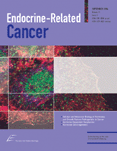| HOME | HELP | FEEDBACK | SUBSCRIPTIONS | ARCHIVE | SEARCH | TABLE OF CONTENTS |
|
|
||||||||
Articles |
Five somatostatin receptor (sst) subtype genes, sst(1), sst(2), sst(3), sst(4) and sst(5), have been cloned and characterised. The five sst subtypes all bind natural somatostatin-14 and somatostatin-28 with high affinity. Endocrine pancreatic and endocrine digestive tract tumours also express multiple sst subtypes, but sst(2) predominance is generally found. However, there is considerable variation in sst subtype expression between the different tumour types and among tumours of the same type. The predominant expression of sst(2) receptors on pancreatic endocrine or carcinoid tumours is essential for the control of hormonal hypersecretion by the octapeptide somatostatin analogues such as octreotide and lanreotide. Somatostatin and its octapeptide analogues are also able to inhibit proliferation of normal and tumour cells. The high density of sst(2) or sst(5) on pancreatic endocrine or carcinoid tumours further allows the use of radiolabelled somatostatin analogues for in vivo visualisation. The predominant expression of sst(2) receptors in these tumours and the efficiency of sst(2) receptors to undergo agonist-induced internalisation is also essential for the application of radiolabelled octapeptide somatostatin analogues. Currently, [(111)In-DTPA(0)]octreotide, [(90)Y-DOTA(0),Tyr(3)]octreotide, [(177)Lu-DOTA(0)Tyr(3)]octreotate, [(111)In-DOTA(0)]lanreotide and [(90)Y-DOTA(0)]lanreotide can be used for this purpose.
This article has been cited by other articles:
 |
M. Grant, H. Alturaihi, P. Jaquet, B. Collier, and U. Kumar Cell Growth Inhibition and Functioning of Human Somatostatin Receptor Type 2 Are Modulated by Receptor Heterodimerization Mol. Endocrinol., October 1, 2008; 22(10): 2278 - 2292. [Abstract] [Full Text] [PDF] |
||||
 |
S. Grozinsky-Glasberg, I. Shimon, M. Korbonits, and A. B Grossman Somatostatin analogues in the control of neuroendocrine tumours: efficacy and mechanisms Endocr. Relat. Cancer, September 1, 2008; 15(3): 701 - 720. [Abstract] [Full Text] [PDF] |
||||
 |
J. Torrisani, N. Hanoun, H. Laurell, F. Lopez, J.-J. Maoret, A. Souque, C. Susini, P. Cordelier, and L. Buscail Identification of an Upstream Promoter of the Human Somatostatin Receptor, hSSTR2, Which Is Controlled by Epigenetic Modifications Endocrinology, June 1, 2008; 149(6): 3137 - 3147. [Abstract] [Full Text] [PDF] |
||||
 |
K. P. Koopmans, O. C. Neels, I. P. Kema, P. H. Elsinga, W. J. Sluiter, K. Vanghillewe, A. H. Brouwers, P. L. Jager, and E. G.E. de Vries Improved Staging of Patients With Carcinoid and Islet Cell Tumors With 18F-Dihydroxy-Phenyl-Alanine and 11C-5-Hydroxy-Tryptophan Positron Emission Tomography J. Clin. Oncol., March 20, 2008; 26(9): 1489 - 1495. [Abstract] [Full Text] [PDF] |
||||
 |
P. Ceppi, M. Volante, A. Ferrero, L. Righi, I. Rapa, R. Rosas, A. Berruti, L. Dogliotti, G. V. Scagliotti, and M. Papotti Thymidylate Synthase Expression in Gastroenteropancreatic and Pulmonary Neuroendocrine Tumors Clin. Cancer Res., February 15, 2008; 14(4): 1059 - 1064. [Abstract] [Full Text] [PDF] |
||||
 |
C. M. Intenzo, S. Jabbour, H. C. Lin, J. L. Miller, S. M. Kim, D. M. Capuzzi, and E. P. Mitchell Scintigraphic Imaging of Body Neuroendocrine Tumors RadioGraphics, September 1, 2007; 27(5): 1355 - 1369. [Abstract] [Full Text] [PDF] |
||||
 |
S. Arena, A. Pattarozzi, A. Massa, J.-P. Esteve, R. Iuliano, A. Fusco, C. Susini, and T. Florio An Intracellular Multi-Effector Complex Mediates Somatostatin Receptor 1 Activation of Phospho-Tyrosine Phosphatase {eta} Mol. Endocrinol., January 1, 2007; 21(1): 229 - 246. [Abstract] [Full Text] [PDF] |
||||
 |
S. V. de Sa, M. L. Correa-Giannella, M. C. Machado, J. J. S de Souza, M. A. A. Pereira, R. A. Patzina, S. A. C. Siqueira, M. C. C. Machado, and D. Giannella-Neto Somatostatin receptor subtype 5 (SSTR5) mRNA expression is related to histopathological features of cell proliferation in insulinomas. Endocr. Relat. Cancer, March 1, 2006; 13(1): 69 - 78. [Abstract] [Full Text] [PDF] |
||||
 |
G A Kaltsas, D Papadogias, P Makras, and A B Grossman Treatment of advanced neuroendocrine tumours with radiolabelled somatostatin analogues Endocr. Relat. Cancer, December 1, 2005; 12(4): 683 - 699. [Abstract] [Full Text] [PDF] |
||||
| HOME | HELP | FEEDBACK | SUBSCRIPTIONS | ARCHIVE | SEARCH | TABLE OF CONTENTS |